Revised 25 January 2022
Accepted 25 November 2022
Available Online 10 January 2023
- DOI
- https://doi.org/10.55060/s.atssh.221230.011
- Keywords
- Lingyin
Ice cellar
Ruins
Heat insulation measures
Drainage facilities - Abstract
Some ice cellar ruins have been unearthed in China. Based on analyzing the data of the ice cellar archaeological site, combined with some records about ancient ice cellars and ice use, this article summarizes the form, ground material, drainage facilities, heat insulation measures and functions of the ice cellar. Ice cellars were technically mature in the Spring and Autumn and Warring States Periods. The way of their construction had a profound influence on the form and structure of the Qin Dynasty and Han Dynasty and continued until the appearance of the modern refrigerator.
- Copyright
- © 2022 The Authors. Published by Athena International Publishing B.V.
- Open Access
- This is an open access article distributed under the CC BY-NC 4.0 license (https://creativecommons.org/licenses/by-nc/4.0/).
1. INTRODUCTION
According to the Book of Songs1, ice is cut in December and stored in Lingyin in the first month. In the Lingyin, where the ice is hidden, one can see that ice cellars existed in the Zhou Dynasty (1046 BC–256 BC), and there were ‘Ling officials’ in charge of collecting ice, storing ice and using ice. In the Zhou Dynasty, ice collection and ice storage were exclusively handled by the imperial court. It is recorded in the Rites of Zhou2 that ice was preserved in the container “Ice Jian”. Ice Jian is a box made of wood or bronze, with a large mouth and a small bottom. At the bottom, there is a drain with a small diameter. After the ice melts, cold water can be discharged directly for use. Unearthed bronze relics from the Warring States Period prove that Ice Jian was already widely used in the imperial court (Fig. 1).
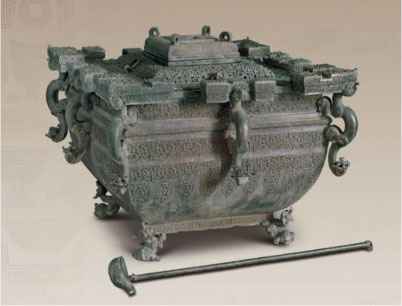
Unearthed cultural relics: bronze “Ice Jian” in the Warring States Period. In: Collection of the National Museum of China.
Lingyin is recorded in many documents of the Qin Dynasty (216 BC–207 BC), Han Dynasty (202 BC – AD 220), Wei, Jin and Southern and Northern Dynasties (AD 220–AD 589) as well as Sui and Tang Dynasties. Ice cellars were originally built by the ruling class for sacrificial rites, summer meals and burial to preserve bodies. Due to the long monopoly of the ruling class, the overall number is also small. Until the Tang Dynasty (AD 618–AD 907), there are references to the appearance of private ice chambers. The Song and Yuan dynasties recorded that people had eaten a large amount of ice and frozen food. During the Ming Dynasty (AD 1368–AD 1644) and Qing Dynasty (AD 1636–AD 1912), the imperial ice cellars entered a period of large-scale construction. During the Republic of China Period (1912–1949), the private commercial ice cellar broke the monopoly. As the capital of the Ming and Qing Dynasties, Beijing is a place where the development of government ice cellars and private ice cellars was concentrated [1].
2. ARCHAEOLOGICAL DISCOVERY OF ICE CELLARS
From the 1960s to the present, many Lingyin sites have been unearthed in China. The following three sites are representative.
2.1. Lingyin Ruin in Yongcheng of Qin State
Yongcheng Lingyin Ruin of the Qin State (the Spring and Autumn Period, 770 BC–476 BC) was unearthed in Fengxiang, Shaanxi province in 1973 (Fig. 2, Fig. 3). The lower part of the site is made of undisturbed and rammed earth, 10m long from east to west, 11.4m wide from north to south, and the four walls are sloping. There is no moisture-proof layer, and there are ditches connected with the surrounding Baiqi River, and the ditches are set with slopes for drainage. Soil containing a large amount of humus was found at the bottom of the cellar, and layers of daubed mud were found around the opening of the cellar [2].
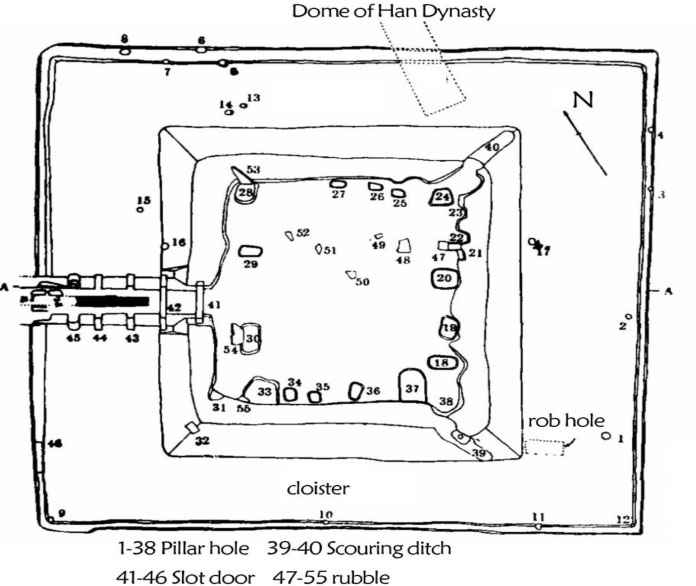
Plan of Lingyin Ruin. Source: [2].
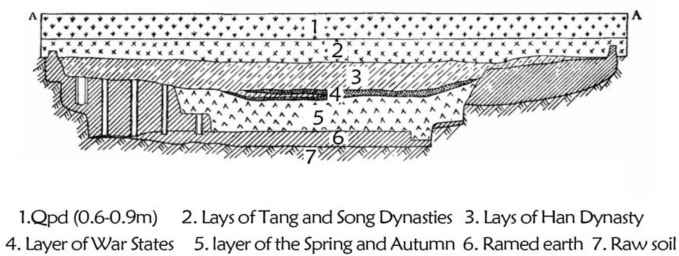
Section of Lingyin Ruin. Source: [2].
2.2. Lingyin Ruin in Zheng-Han Ancient City
In 1965, in Xinzheng County, Henan Province, the ruins of refrigerated rooms in the ancient city of Zheng-Han (475 BC–221 BC) during the Warring States Period were unearthed (Fig. 4, Fig. 5). The site is 8.7m long from north to south, 2.5m wide from east to west and about 3m deep. There is a stepped entrance 0.56–1.15m wide in the southeast corner. The floor is paved with square bricks and the walls are inlaid with square bricks. There are 5 shafts inside, which are connected by prefabricated pottery traps. The area of the shaft mouth accounts for 1/3 of the basement bottom area, and the well is about 2.5m deep [3,4].
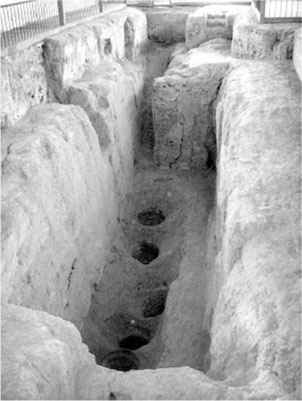
Ice cellar in Zheng-Han ancient city. Source: https://baijiahao.baidu.com/s?id=1722004891128570475&wfr=spider&for=pc.
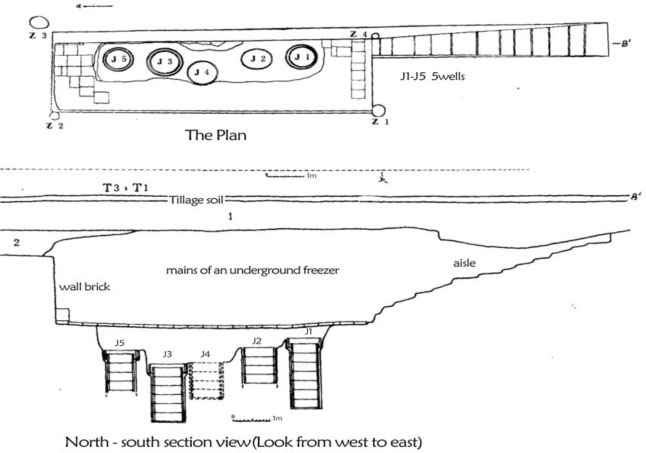
Plan and section of ice cellar in Zheng-Han ancient city. Source: [3].
2.3. Changle Palace Lingyin Ruin, Chang'an City (Han Dynasty, 202 BC – AD 220)
In 2004, the Lingyin Ruin has been discovered northwest of the Changle Palace site of the Han Dynasty in Xi'an (Fig. 6). The main chamber is 27m long from east to west and 6.7m wide from north to south. It is a shallow underground building with a depth of 0.14–0.5m. There are wide rammed earth walls around, the ground tiled brick. There are 19 ditches in the north and south connected with the main ditch running east and west. The eastern end of the ditch is connected with a drainage pipe running through the east wall [5].
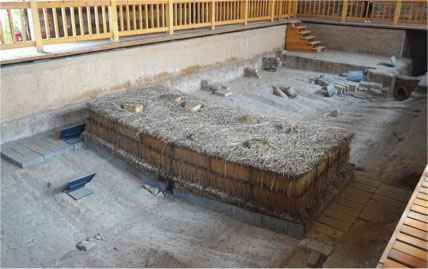
Changle Palace Lingyin Ruin. Source: https://m.sohu.com/a/227191942_428863/?pvid=000115_3w_a.
3. ARCHAEOLOGICAL ANALYSIS OF ICE CELLARS
3.1. Ice Cellar Form and Structure
A large number of wooden tiles and cylinder tiles were unearthed from the ruins of Yongcheng which was in the Spring and Autumn Period. There are cloisters around the square pit. There are four kinds of column caves: square, rectangular, round and oval, and the buried depths are different, which fully proves that there are not only underground pits and caves in Lingyin, but also buildings on the ground. The ruins of Zheng-Han's ancient city during the Warring States Period is 3m deep underground, and 5.5m deep at the bottom of five wells, which is the deepest pit among the three sites. Changle Palace Lingyin Ruin of the Han Dynasty is a shallow underground building supported by thick rammed earth walls and surrounded by a circle of corridors. It can be seen that underground cellars and buildings above the ground form the basic shape of Ling Yin [6].
3.2. Ice Cellar Ground Material and Drainage Facilities
Due to the limitation of the preservation environment and method, the cellar ice would melt by itself before use. Therefore, the ice storage needs to make a good advance, and collect far more ice than the demand, drainage facilities are also essential. There is no moisture-proof layer on the ground of the crypts of Yongcheng Lingyin Ruin. The cellar bottom is a layer of sandy schist that drains more easily than rammed earth and keeps the ice clean. At the bottom of the second channel door, there is a channel leading to the surrounding river. The pit floor of Zheng-Han's ancient city Ruin is paved with square bricks, and the 5 internal shafts are connected by pottery well traps. Some scholars believe it was a deep well for storing food, while others believe it was used for drainage and seepage. Personally, it is very inconvenient to take food from a deep well, but drainage is more reasonable. The north and south sides of the Changle Palace Lingyin Ruin incline to the middle, connected to the drainage ditch to the middle, the ground tiled brick. The meltwater produced by the ice is discharged from the drain through the pottery drain under the east wall. From the perspective of the ground materials of the three sites, the use of brick and schist is conducive to the clean ice, but also prevents the erosion of the ground by water, and protects the safety of the pit [7].
3.3. Ice Cellar Heat Insulation Technology
A large number of humus soil layers were found at Lingyin Ruin in Yongcheng, and mud marks were found at the Cellar mouth. This also confirms that the heat insulation of the ice cellar in ancient books is covered with straw and sealed with mud. Above the walls are rammed earth slopes. In the west corridor of the passage, from west to east there are five channel doors, each channel door is 1–1.2m apart, used to strictly isolate the outdoor hot air. Lingyin Ruin of Zheng-Han ancient city is a deeply buried building, which is conducive to the constant internal temperature. Five deep wells also allow the underground air to maintain the freezing point temperature. Although the Changle Palace Lingyin Ruin is shallow underground, the walls of the upper buildings are very thick. The south wall is 5.5m thick, the west wall is 4–4.6m, the east wall is 3.9m, and the north wall is 3.5–3.7m thick. The south wall, which is much hotter, is the thickest, and the north wall is the thinnest, with good insulation characteristics. The heat insulation of the ice cellar depends on the depth of the underground, and the walls of the ground buildings should have enough thickness for heat insulation. In addition, the ice cellar is generally covered with an insulation layer. The thick straw and mud seal of multiple layers play the role of upper heat insulation [8].
3.4. Ice Cellar Function
The Yongcheng Ruin and Changle Palace Ruin were identified by archaeologists as ice storage sites, which were relatively large and had drainage facilities on the ground. But Zheng-Han cultural Ruin had mining of residual, such as cattle, pigs and sheep bones, and the characteristic of the deeply buried depth concluded that the site is for refrigerated or frozen meat. Five wells make the air temperature cooler and more suitable for refrigeration. Not just like the Yongcheng Ruin and Changle Palace Ruin pit bottom brick paving, in the Zheng-Han Lingyin Ruin, the rammed earth wall sticks around the back were square groove bricks which make storage space cleaner.
4. CONCLUSION
Lingyin is the building where the ancient Chinese royal family hid the ice. In the Spring and Autumn Period and the Warring States Period in China, people mastered ice storage. In the ice cellar heat insulation, ice cellar drainage and internal surface wall material technology have been relatively mature. The basic form of ice cellar in the Qin and Han dynasties was inherited and retained and was still used by the ruling class in successive dynasties. The basic form has a profound impact on future generations, and has been used until the Ming and Qing Dynasties and the Republic of China until the emergence of refrigerators, which reflects the wisdom of ancient Chinese people and is the physical witness of history [9].
Footnotes
The Book of Songs is the first anthology of verse in China. It collected poems from the early Western Zhou Dynasty to the middle of the Spring and Autumn Period (11th–6th century BC).
The Rites of Zhou, written in the Western Zhou Dynasty, recorded the social politics, economy, culture, customs and rites, and regulations of the pre-Qin period.
REFERENCES
Cite This Article

TY - CONF AU - Haiying Li PY - 2023 DA - 2023/01/10 TI - Study on the Ice Cellar Ruins in Early Ancient China BT - Proceedings of the 4th International Conference on Architecture: Heritage, Traditions and Innovations (AHTI 2022) PB - Athena Publishing SP - 81 EP - 85 SN - 2949-8937 UR - https://doi.org/10.55060/s.atssh.221230.011 DO - https://doi.org/10.55060/s.atssh.221230.011 ID - Li2023 ER -









